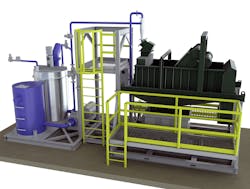A New Look at Recycling Green Sand Wastes
Despite numerous challenges to its long-term viability — some serious and credible, others just imagined or mistaken — green sand casting is thriving, both in practical terms and in its technological progress. But one constant dilemma for producers of green sand castings is what to do with the byproducts.
For background, green-sand casting involves molds formed with silica (or chromite, or zircon) sand mixed with water and bonding compounds, notably bentonite (clay) and carbon. Finished castings ultimately leave their molds but the bonded sand remains, and what to do with that sand is one of those challenges that green-sand casters routinely discuss. Reportedly, the U.S. foundry industry consumed approximately 700,000 tons of bentonite and carbon during 2018.
Another dimension to the challenge is regulatory. As noted, silica sand is one of the primary components of green sand, and following the U.S. EPA's 2018 implementation of more stringent Permissible Exposure Limits for airborne silica, foundries have adopted more effective and comprehensive systems for collecting sand and dust, including bentonite and carbon, which generally is landfilled. One estimate put the annual U.S. volume of landfilled dust from casting processes at close to 1 million tons, which would mean up to 150,000 tons/year of bentonite and carbon that might be recovered. In a recent report, Imerys High Temperature Solutions, Foundry Div. director of Sales & Business Development Tim McMillin estimated the recovery value of those materials at $45 million.
"The need for a process to recover usable bentonite and carbon from the dust collector 'waste' has been recognized for decades," McMillin wrote. "However, the bentonite is typically bonded to the fine sand particles and very difficult to separate. Both dry and wet process have been tried …, but with limited success."
The difficulty is how to separate the clay and carbon efficiently from the sand fines that are collected: The large surface area of the fine sand, combined with the bonding strength of the bentonite makes separation difficult. Both dry and wet treatment processes have been tried, including chemical accelerators, without much success in technical or cost terms.
Imerys offers a patented technology called the RIKO® process for recovering usable bentonite and carbon from foundry dust. In the process, water is the only constituent added to the dust. Intensive hydraulic separation, specific gravity differences, and mechanical screening provide a simple and efficient method for recovery, as demonstrated by an 83% recovery rate for useable bentonite and carbon.
RIKO uses high-shear mixing, hydro-cyclonic separation, and screening to produce a slurry that is 23% solids by volume, solids that typically are comprised of 68% hydrated clay and 32% lustrous carbon. This bentonite/carbon slurry is added back into the sand preparation process, where it can replace 20-30% of water, bentonite, and carbon (based on the amount added) needed for green-sand preparation.
As the RIKO material is pre-hydrated it exhibits better binding and sand property performance compared to traditional dry materials, according to Imerys. The recovered bentonite and carbon is at least 50% lower in total cost compared to standard dry bentonite and carbon.
The developer noted there is no need for a capital equipment investment by a foundry; Imerys is responsible for CapEx and licensing, and collects a monthly charge based on the amount of material produced and /consumed. The foundry operates the system and pays all variable expenses, while Imerys provides remote monitoring and regular field technical assistance.
Looking forward, McMillin reported that a dry separation method is still in development, but that it would allow for a much higher recovery rate and greater foundry-market capture. That research involves a similar cyclonic removal technique, but does not introduce water. "While less efficient, this dry technique does not limit the amount of material that can be re-introduced into the foundry sand system," according to McMillin.
